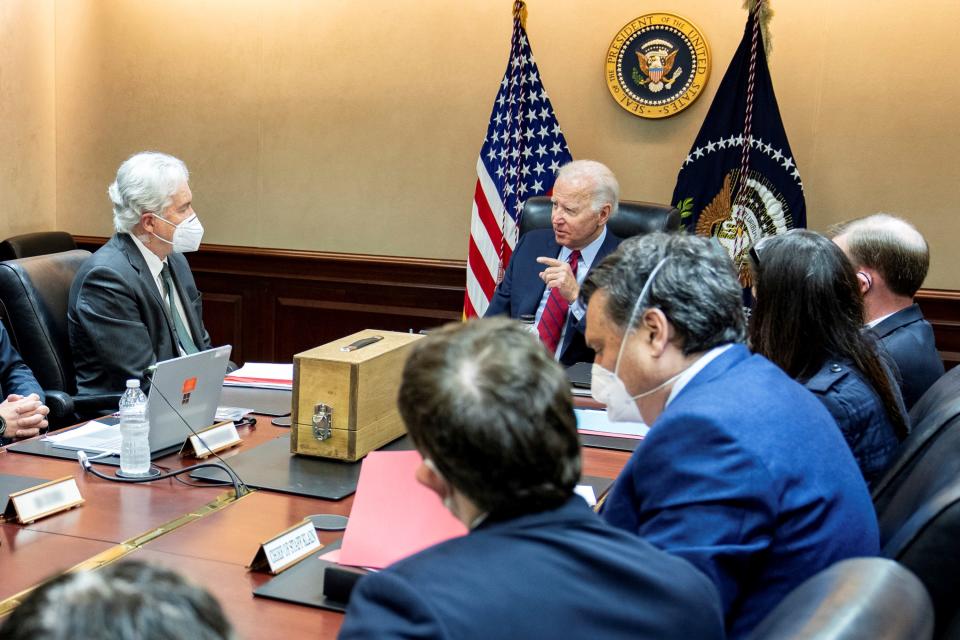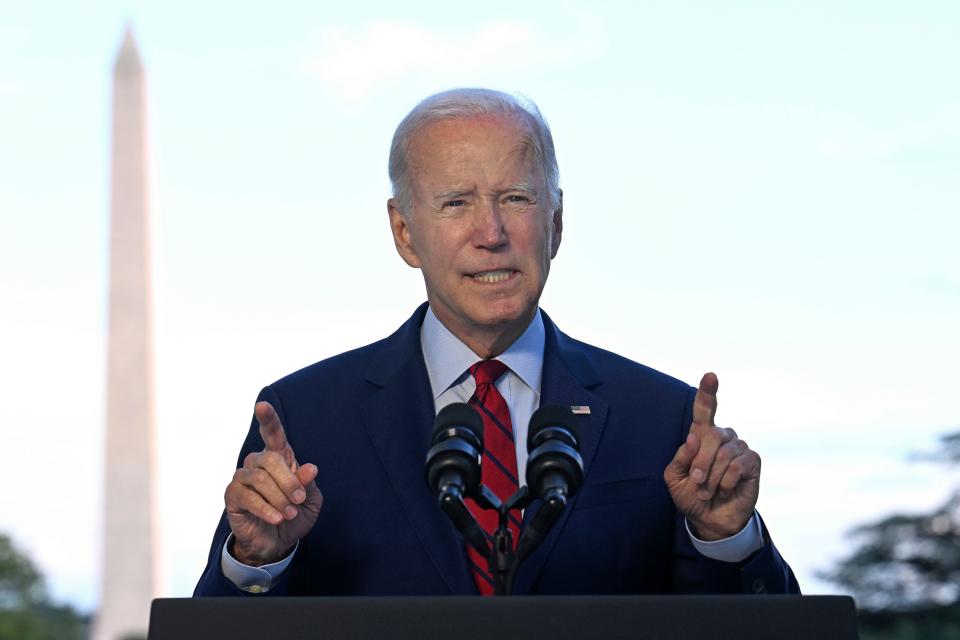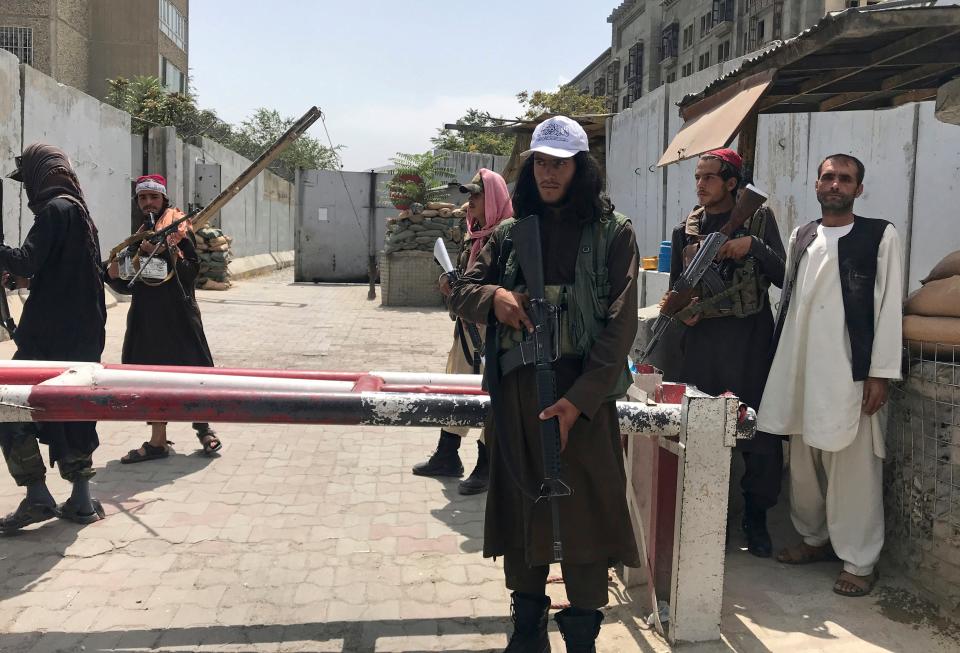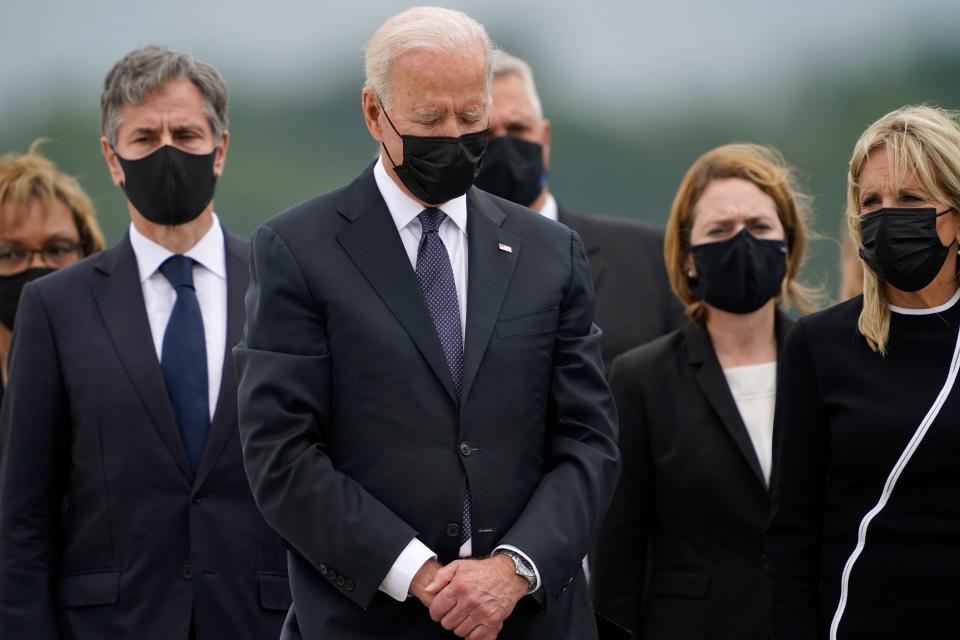Despite drone strike on al-Qaida leader, many fear Afghanistan remains haven for terror a year after US exit
WASHINGTON – For President Joe Biden and his allies, the CIA drone strike that killed al-Qaida's top terrorist vindicated Biden's decision a year ago to withdraw U.S. troops from Afghanistan and proved that the U.S. can attack militants from afar.
To skeptics, it highlighted the vacuum created by the U.S. withdrawal and the perils of a Taliban-led Afghanistan where Islamic terrorist groups continue to operate and even thrive.
The July 30 operation eliminated one of the world's most-wanted terrorists, Ayman al-Zawahri, an architect of the 9/11 attacks.
The strike came almost one year after the last U.S. troops left Afghanistan, at Biden's direction, ending the 20-year war triggered by 9/11.
"When I ended our military mission in Afghanistan almost a year ago, I made the decision that after 20 years of war, the United States no longer needed thousands of boots on the ground in Afghanistan to protect America from terrorists who seek to do us harm," Biden said. "I made a promise to the American people that we would continue to conduct effective counterterrorism operations in Afghanistan and beyond. We’ve done just that.”
Indeed, no U.S. troops were put in harm's way to kill al-Zawahri. The U.S. launched two Hellfire missiles at the balcony of a safe house in Kabul where al-Zawahri and his family had been living, according to a senior U.S. official. No Americans were on the ground in the capital, the official said.

Who was Ayman al-Zawahri?Master strategist for al-Qaida was Osama bin Laden's mentor, then successor
Yet Biden's "over-the-horizon" approach to combating terrorists in Afghanistan faces renewed questions among former counterterrorism officials and the government's own assessments of the threat from al-Qaida and ISIS-Khorasan, also known as ISIS-K, a once obscure offshoot of the militant Islamic State terrorist group.
Killing a top terrorist wanted for decades is a significant feat. Keeping tabs on thousands of terrorists from afar is a different matter, especially when many of them have been streaming into Afghanistan since the U.S. left.

Critics say it's foolish to believe that the U.S. military and intelligence capabilities, as sophisticated as they are, can detect and destroy terrorist plots thousands of miles away.
"I remain very skeptical," said Mark Quantock, a retired two-star Army general who oversaw intelligence collection for U.S. Central Command. "There simply isn't sufficient collection assets – human and technical – to maintain adequate situational awareness."
Even the Pentagon acknowledges that without pressure, terrorists in Afghanistan may have the ability to attack the United States by next spring – a possibility that critics of the U.S. withdrawal had warned of.
A resurgent al-Qaida?
As part of the Trump administration's deal to withdraw from Afghanistan, the Taliban pledged to cut ties with al-Qaida and to keep the country from once again becoming a safe haven for terrorist groups.
But Taliban leaders have reneged on that promise, instead solidifying their longstanding relationship with al-Qaida. A recent United Nations report concluded that key al-Qaida allies have consolidated power in Afghanistan – with help from the Taliban – providing the terror network with a platform from which to mount a comeback and plot attacks.
That concerns U.S. and allied counterterrorism officials, many of whom believe the group once led by Osama bin Laden presents the most lethal threat to U.S. interests at home and abroad.
Colin Clarke, a South Asia terror expert and research director at the Soufan Group, believes that al-Qaida, and to a lesser extent ISIS-K, will spend the next year trying to develop the capability to strike Western targets, including train stations and other "soft" civilian facilities.
Like some other experts, Clarke also believes an intensifying rivalry between al-Qaida and ISIS-K is causing both groups to look for ways to launch high-profile attacks in order to recruit and raise money off of them.
While al-Qaida remains a mostly hierarchical top-down organization, ISIS-K is instructing its followers to return to their home countries and launch whatever kind of attacks they want.
“Which group can launch the kind of major attack that will differentiate themselves remains to be seen,” Clarke told USA TODAY. But, he added, both of them want to generate more attention for themselves.
“They want to be able to say, ‘We’re not the kind of guys that sit around and talk. We can get things done,’" Clarke said.
Identifying whether – and, if so, when – ISIS-K and al-Qaida can successfully attack Western targets outside of Afghanistan “is our main intelligence priority,” National Counterterrorism Center Director Christine Abizaid said in a recent podcast interview.
Without the official U.S. presence in Afghanistan, Washington is going to have to find a way to put spies on the ground in order to augment strikes launched from over the horizon, Abizaid said.
"We do denied-area operations all over the world and against really hard targets," Abizaid said, referring to CIA operations in openly hostile territory controlled by adversaries. "And we're going to have to build that for Afghanistan as well."

'Sheer folly': What know (and don't) about the current threat
Amid the chaos of the U.S. retreat from Afghanistan in August 2021, red lights flashed to senior U.S. military and intelligence officials that an attack loomed.
The target was obvious: Hamid Karzai International Airport, where hundreds of U.S. troops guarded the gates of the last exit for tens of thousands of Afghans, U.S. citizens and others seeking to flee the revanchist Taliban and its austere, cruel policies. The suspected perpetrator was ISIS-K.
What is ISIS-K? Islamic State terror group carried out Kabul attack that killed 13 U.S. troops
On Aug. 26, an ISIS-K terrorist hauling 20 pounds of military-grade explosives and 5-milimeter ball bearings threaded his way through the crowd to the airport gate. He detonated the vest, killing 13 U.S. troops and at least 170 Afghans. The blast wounded 45 U.S. troops.
ISIS-K is known for its particularly virulent savagery. Among other tactics, the group has been known to target maternity clinics and girls schools for Shia Muslims.
ISIS-K spawned from ISIS, the militant group that erupted in 2014 in Iraq, spilled across the border into Syria and seized a vast patch of desert and cities. At its zenith, the so-called caliphate of ISIS occupied about 40% of Iraq and about one-third of Syria. U.S. warplanes spearheaded a counteroffensive that pummeled ISIS militants, and local ground forces clawed back virtually all of its geographic gains.
Estimates of the group's current strength vary widely, U.S. officials say, due largely to the lack of on-the-ground intelligence gathering.
'I cannot pretend to be OK':Afghan refugees torn between new lives in US and haunting reality of home
For 20 years, beginning with the U.S. invasion to topple the Taliban when it harbored al-Qaida terrorists responsible for the 9/11 attacks, the Pentagon and intelligence agencies had a physical presence in Afghanistan. They collected intelligence with technology that intercepted communications and surveilled groups from the sky and space.
But some of the best information came from informants and the eyes and ears of more than 100,000 U.S. troops on the ground.
Without that human capability, there's more uncertainty. A military official with access to current intelligence estimates, who was not authorized to speak publicly, estimated between 2,000 and 5,000 ISIS-K militants remain in Afghanistan. They continue to attack civilians and the Taliban.
"I am very suspect of any claim that we know what's happening inside Afghanistan," said Quantock, the former U.S. Central Command officer. "It's sheer folly to think we've got a good handle on threats developing, emanating from the vastness that is Afghanistan."
The government's best estimate is that ISIS-K could have the capability to attack the United States and its allies as soon as March, according to a Defense Department assessment released this spring. Al-Qaida militants are probably six months behind.
Attacks could come sooner if ISIS-K unexpectedly gains strength, the assessment warned.
"We know there are bad guys in Afghanistan – ISIS-K and al-Qaida," said a senior administration official who also has access to intelligence but was not allowed to speak publicly. A threat from ISIS-K outside Afghanistan is possible within a year, but there are no indications of an imminent attack, the official said.
Douglas London, the CIA’s former top Afghanistan counterterrorism official, said he does not believe that terrorism emanating from Afghanistan is a significant threat to U.S. interests here or abroad in the short term.
London, a 34-year veteran of the CIA's Clandestine Service who retired in 2019, said he does not view ISIS-K in particular – and the other ISIS affiliates around the world – as a threat to the United States because their focus is more local and regional, not on the West. London, author of the 2021 book "The Recruiter: Spying and the Lost Art of American Intelligence," now consults for private enterprises and U.S. intelligence agencies on national security matters.
Al-Qaida is much more of a threat than ISIS-K, London said, since its leaders have always targeted the West.
Olivia Troye, who served as the homeland security and counterterrorism adviser to Vice President Mike Pence during the Trump administration, said the threat from ISIS-K, al-Qaida and other terrorist groups remains and will grow in Afghanistan, due to the vacuum created by America's chaotic departure.
“It is an increasing sanctuary for terrorist organizations where all of these networks are now overlapping with each other, and it's a prime training ground for them,” said Troye, who also worked at the National Counterterrorism Center and Department of Homeland Security.
The limits of an 'over-the-horizon' strategy
The Biden administration's "over-the-horizon" approach relies on monitoring terrorist groups from a distance and attacking when threats emerge. The Pentagon has dedicated a task force to the mission, which it acknowledges is "difficult but not impossible." The attack that killed al-Zawahri offers some proof of the concept.
“Go ask other al-Qaida leaders how safe they feel in Afghanistan right now,” John Kirby, coordinator for strategic communications at the National Security Council, said in an interview with USA TODAY.
Senior administration officials familiar with the security situation in Afghanistan estimate that fewer than 200 individuals affiliated with al-Qaida are currently operating out of Afghanistan, and the number has not increased dramatically since the U.S. military departed.
The precision strike on al-Zawahri demonstrated that the U.S. posture toward Afghanistan is the correct one, said Zalmay Khalilzad, the former U.S. Special Representative for Afghanistan Reconciliation who led the Trump administration's negotiations with the Taliban. Those talks resulted in a deal with the Taliban that set a timetable for the U.S. withdrawal.
“We proved the concept that you can do operations against terrorism in Afghanistan without having forces there and that operation was well done,” said Khalilzad.
But among the chief limitations of the Biden administration's strategy is the "finite number" of missions that drones can fly "to develop and potentially strike terrorist targets in Afghanistan," the Pentagon's assessment notes. Flying from a base in the Middle East, an armed drone has a limited amount of time over Afghanistan before running low on fuel, the military official said.
The Biden administration is still trying to negotiate agreements to station U.S. drones in countries closer to Afghanistan, the administration official said. Having drones closer would allow the U.S. to lengthen the duration of its patrols and respond more quickly to an emerging threat.
The al-Zawahri strike was the first such attack since the U.S. withdrawal. "We have many ways to do the job," the administration official said. "The tools are in place."
For attacking al-Qaida targets, the U.S. clearly cannot rely on the Taliban. Senior Taliban leaders were aware of al-Zawahri’s location, according to a U.S. official who called it a "clear violation" of the Trump-era agreement deal with the Taliban.

But the Taliban might offer the best path to keeping ISIS-K in check, an awkward position for Washington.
"It is our assessment that the Taliban and ISIS-K are mortal enemies," said Colin Kahl, the Pentagon's undersecretary for policy. "So the Taliban is highly motivated to go after ISIS-K. Their ability to do so, I think, is to be determined."
In a recent analytic report, the independent research arm of Congress also concluded that the Taliban presented a potentially significant ally against ISIS. But it also said it cannot predict whether the Taliban can contain a terror network that now has at least 16 affiliates worldwide.
“Experts disagree about the potency of the (ISIS-K) threat and the Taliban’s self-asserted ability to counter the group without external assistance,” said the June 22 report by Congressional Research Service analyst Clayton Thomas.
So far, Thomas concluded, ISIS-K appears to be winning the battle: "Since the Taliban takeover, ISKP’s ranks have swelled to as many as 4,000 fighters despite a concerted Taliban offensive.” ISKP is another way to identify ISIS-K. It stands for Islamic State Khorasan Province and is commonly used by U.S. officials.
The report, prepared for members of Congress, added that a series of major attacks claimed by or attributed to ISIS-K this past spring “raises the prospect of greater violence,” especially against Afghanistan’s Shia minority, the Hazaras. And it concluded that some former members of the Afghan National Defense and Security Forces “have reportedly taken up arms with ISKP, purportedly attracted in part by ISKP cash payments.”
Contributing: Francesca Chambers

More:
'Egregiously mishandled' or inevitably 'messy'? What went wrong in US withdrawal from Afghanistan
Biden and Trump administrations didn't miss ISIS-K threat – they ignored it, experts say
This article originally appeared on USA TODAY: Biden: US strike killing al-Zawahri in Kabul vindicates withdrawal
